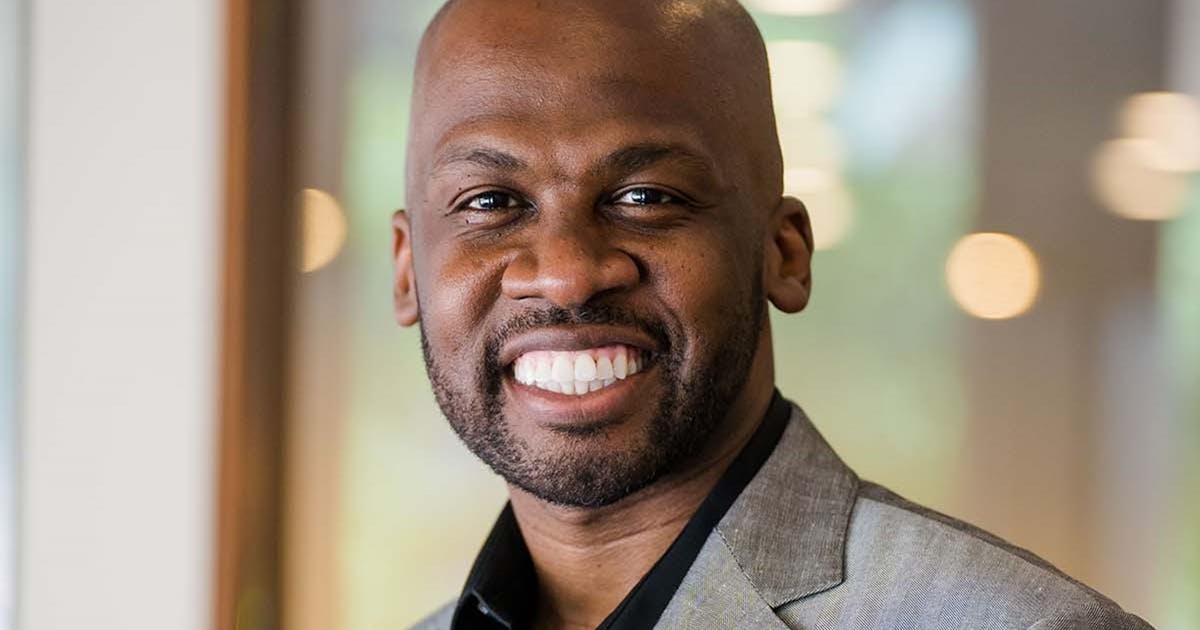
Christopher Harrington, 39, is president and CEO of the nonprofit Ordway Center for the Performing Arts. He arrived in St. Paul from Detroit in 2021, taking the helm as the center reopened with the financial impact of a global pandemic still echoing. Harrington said the most challenging — and rewarding — part of his job is connecting audiences more deeply to the arts.
The Ordway opened in 1985 and is home to dozens of performances every year, ranging from Broadway musical theater to classical music, dance, opera and other performing arts.
After nearly a decade at the Detroit Symphony Orchestra, where he worked to increase and diversify its audience, Harrington seeks to build up the Ordway’s audience by strengthening the relevance of the arts in their lives.
Eye On St. Paul recently visited with the Ordway’s young leader to learn more. This interview was edited for length.
Q: What has been the most fun for you in this job?
A: I love musical theater. I love the arts. It’s something that I’ve been doing for the majority of my career. I really love connecting with audiences who come to shows. I love being out in the audience and just hearing their reactions, just the stories that you hear from people coming here. Whether it’s hearing someone talking in Rice Park or in our atrium. Whether it’s hearing talk about “Peter Pan” from someone who’s going through a tragic moment in their life. Those are the moments that really give me the power and the energy to keep going.
Q: What are the biggest differences you’ve found here compared to Detroit?
A: I think there is an inherent spirit of collaboration in the Twin Cities that exists everywhere. But it’s almost like it’s expected here. If you aren’t collaborating, people are kind of skeptical. I’ll give you an example of that. The Ordway is part of what’s known as the Arts Partnership … comprised of the Schubert Club, the St. Paul Chamber Orchestra, [the Ordway] and the Minnesota Opera. And we work collaboratively to share and activate this space. The fact that we’re working together to share an asset, that’s something that doesn’t exist anywhere else in the world.
Q: Support for the arts feels fragile sometimes. How do you increase support?
A: I am grateful to be in a community where we have sponsors that have supported us, even when we were dark and we couldn’t allow audiences in. During the pandemic, we still had some of our closest donors and sponsors who stood by us and say, “Hey, we want to see you thrive on the other side of this.”
What we know in analyzing the data is that corporate sponsorship and philanthropy is down, not only in the Twin Cities, but around the country. I think we have to continue to make the case for why the arts matter. Every thriving community needs to have a thriving arts scene. We need to make a case for how this aligns with priorities for the city. We’ve been talking about how to better integrate the arts and humanities into everyday life.
Q: Why do the arts matter?
A: There’s research that shows the healing power of the arts. If you think of the last three years, we’ve all been through something traumatic. When you’re coming to a place like the Ordway, whether you’re seeing “Peter Pan” or a symphonic orchestra or an opera, you’re not thinking about the things that are different in the person sitting next to you. You are connecting [with them] in a meaningful way.
If it’s a passport to escapism or it’s an opportunity to be inspired, that’s one of the benefits. But I also think that it’s critical to downtown areas and communities thriving. When we have 40,000 people here in downtown St. Paul, guess what? Restaurants are doing great business. The mom-and-pop shops around the Ordway are doing great as well. There is just this palpable energy.
Q: What unique qualities do you bring?
A: At my core, I’m a connector. I would say that’s my superpower. Connecting what we do to what might be important to a donor. Connecting what we do to what might be priorities for a corporation. I have been connected to the arts my entire career. If it is Broadway, if it is theater, if it is jazz, people still need to understand how this fits in the whole ecosystem.
Q: If I have never set foot inside the Ordway before, what is the biggest surprise I’m going to encounter?
A: Sally Ordway Irvine had this vision of creating a space where all of the performing arts can be celebrated and where all people can feel welcome. So I would say the hospitality and the sense of welcome that you feel when you arrive from our amazing team here at the Ordway is a surprise. Most people when they walk in, it’s so fancy. Students who come here for the first time just marvel at the sense of feeling special.
Q: What’s at the top of your wish list?
A: When I look at the landscape of performing arts centers around the country, we’re still in this recovery period. I want to see a healthy, thriving mission-driven organization with a sustainable business model that is centered around our role in this community as a driver for artistic, educational, cultural and social vitality. And I think all those things are really interconnected and we need support to ensure that it happens. We’re in the middle of a campaign now. So getting the support of this community is definitely on my wish list.
